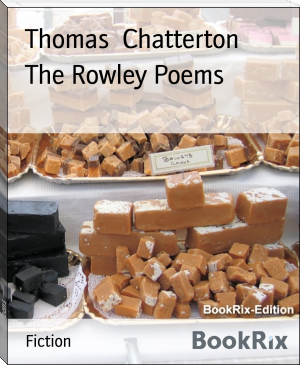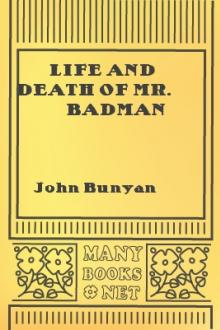The Rowley Poems, Thomas Chatterton [buy e reader txt] 📗

- Author: Thomas Chatterton
Book online «The Rowley Poems, Thomas Chatterton [buy e reader txt] 📗». Author Thomas Chatterton
EDITOR'S INTRODUCTION
CHATTERTON'S LIFE AND DEATH AND THE GENESIS OF THE ROWLEY POEMS
THE VALUE OF THE ROWLEY POEMS
III. BIBLIOGRAPHY
NOTE ON THE TEXT
NOTES
APPENDIX ON THE ROWLEY CONTROVERSY
REPRINT OF THE EDITION OF 1778. (The Table of Contents follows the
1778 title-page.)
EDITOR'S INTRODUCTION. (I. CHATTERTON'S LIFE AND DEATH AND THE GENESIS OF THE ROWLEY POEMS)
Thomas Chatterton was born in Bristol on the 20th of November 1752.
His father--also Thomas--dead three months before his son's birth, had
been a subchaunter in Bristol Cathedral and had held the mastership
in a local free school. We are told that he was fond of reading and
music; that he made a collection of Roman coins, and believed in magic
(or so he said), studying the black art in the pages of Cornelius
Agrippa. With all the self-acquired culture and learning that raised
him above his class (his father and grandfathers before him for
more than a hundred years had been sextons to the church of St. Mary
Redcliffe) he is described as a dissipated, 'rather brutal fellow'.
Lastly, he appears to have been 'very proud', self-confident, and
self-reliant.
Of Chatterton's mother little need be said. Gentle and rather foolish,
she was devoted to her two children Mary and, his sister's junior by
two years, Thomas the Poet. Of these Mary seems to have inherited the
colourless character of her mother; but Thomas must always have been
remarkable. We have the fullest accounts of his childhood, and the
details that might with another be set down as chronicles of the
nursery will be seen to have their importance in the case of this boy
who set himself consciously to be famous when he was eight, wrote
fine imaginative verse before he was thirteen, and killed himself aged
seventeen and nine months.
Thomas, then, was a moody baby, a dull small boy who knew few of his
letters at four; and was superannuated--such was his impenetrability
to learning--at the age of five from the school of which his father
had been master. He was moreover till the age of six and a half so
frequently subject to long fits of abstraction and of apparently
causeless crying that his mother and grandmother feared for his
reason and thought him 'an absolute fool.' We are told also by his
sister--and there is no incongruity in the two accounts--that he
early displayed a taste for 'preheminence and would preside over his
playmates as their master and they his hired servants.' At seven and
a half he dissipated his mother's fear that she had borne a fool
by rapidly learning to read in a great black-letter Bible; for
characteristically 'he objected to read in a small book.' In a very
short time from this he appears to have devoured eagerly the contents
of every volume he could lay his hands on. He had a thirst for
knowledge at large--for any kind of information, and as the merest
child read with a careless voracity books of heraldry, history,
astronomy, theology, and such other subjects as would repel most
children, and perhaps one may say, most men. At the age of eight
we hear of him reading 'all day or as long as they would let him,'
confident that he was going to be famous, and promising his mother and
sister 'a great deal of finery' for their care of him when the day of
his fame arrived. Before he was nine he was nominated for Colston's
Hospital, a local school where the Bluecoat dress was worn and at
which the 'three Rs' were taught but very little else, so that the
boy, disappointed of the hope of knowledge, complained he could
work better at home. To this period we should probably assign the
delightful story of Chatterton and a friendly potter who promised to
give him an earthenware bowl with what inscription he pleased upon
it--such writing presumably intended to be 'Tommy his bowl' or 'Tommy
Chatterton'. 'Paint me,' said the small boy to the friendly potter,
'an Angel with Wings and a Trumpet to trumpet my Name over the World.'
At ten he was making progress in arithmetic, and it should be
mentioned that he 'occupied himself with mechanical pursuits so that
if anything was out of order in the house he was set to mend it.' At
school he read during play hours and made few friends, but those
were 'solid fellows,' his sister tells us; while at home he had
appropriated to himself a small attic where he would read, write
and draw pictures--a number of which are preserved in the British
Museum--of knights and churches, and heraldic designs in red and
yellow ochre, charcoal, and black-lead. In this attic too he had
stored--though at what date is uncertain--a number of writings on
parchment which had a rather singular history. In the muniment room
of St. Mary Redcliffe, the church in which Chatterton's ancestors had
served as sextons, there were six or seven great oak chests, of which
one, greater than the others and secured by no fewer than six locks,
was traditionally called 'Canynges Cofre' after William Canynge the
younger, with whose name the erection and completion of St. Mary's
were especially associated. These had contained deeds and papers
dealing with parochial matters and the affairs of the Church, but some
years before Chatterton's birth the Vestry had determined to examine
these documents, some of which may have been as old as the building
itself. The keys had in the course of time been lost, and the
vestrymen accordingly broke open the chests and removed to another
place what they thought of value, leaving Canynge's Coffer and its
fellows gutted and open but by no means void of all their ancient
contents. Such parchments as remained Chatterton's father carried
away, whole armfuls at a time, using some to cover his scholars' books
and giving others to his wife, who made them into thread-papers and
dress patterns.
In the house to which Mrs. Chatterton had moved upon her husband's
death there was still a sufficient number of these old manuscripts to
make a considerable trove for the boy who, then nine or ten years old,
had first learnt to read in black-letter and was in a few years to
produce poetry which should pass for fifteenth century with many
well-reputed antiquaries. It was no doubt on blank pieces of these
parchments that he inscribed the matter of the few Rowley documents
which he ever showed for originals. We have the account of a certain
Thistlethwaite, one of the 'solid lads' with whom Chatterton had made
friends at school, that his friend Thomas in the summer of 1764
told him 'he was in possession of some old MSS. which had been found
deposited in a chest in Redcliffe Church, and that he had lent some or
one of them to Thomas Phillips'--an usher at Colston's, an earnest
and thoughtful man fond of poetry, and a great friend of Chatterton's.
'Within a day or two after this,' (Thistlethwaite wrote to Dean
Milles,) 'I saw Phillips ... who produced a MS. on parchment or vellum
which I am confident was "Elenoure and Juga"[1] a kind of pastoral
eclogue afterwards published in the _Town and Country Magazine_ for
May 1769. The parchment or vellum appeared to have been closely pared
round the margin for what purpose or by what accident I know not ...
The writing was yellow and pale manifestly as I conceive occasioned by
age.'
This was the beginning of the Rowley fiction--which might be
metaphorically described as a motley edifice, half castle and half
cathedral, to which Chatterton all his life was continually adding
columns and buttresses, domes and spires, pediments and minarets,
in the shape of more poems by Thomas Rowley (a secular priest of St.
John's, Bristol); or by his patron the munificent William Canynge
(many times Mayor of the same city); or by Sir Thibbot Gorges, a
knight of ancient family with literary tastes; or by good Bishop
Carpenter (of Worcester) or John à Iscam (a Canon of St. Augustine's
Abbey, also in Bristol); together with plays or portions of
plays which they wrote--a Saxon epic translated--accounts of
Architecture--songs and eclogues--and friendly letters in rhyme or
prose. In short, this clever imaginative lad had evolved before he
was sixteen such a mass of literary and quasi-historical matter of
one kind or another that his fictitious circle of men of taste and
learning (living in the dark and unenlightened age of Lydgate and the
other tedious post-Chaucerians) may with study become extraordinarily
familiar and near to us, and was certainly to Chatterton himself quite
as real and vivid as the dull actualities of Colston's Hospital and
the Bristol of his proper century.
Chatterton's own circle of acquaintance was far less brilliant. His
principal patrons were Henry Burgum and George Catcott, a pair of
pewterers, the former vulgar and uneducated but very ambitious to be
thought a man of good birth and education, the latter a credulous,
selfish and none too scrupulous fellow, a would-be antiquary, of
whom there is the most delightfully absurd description in Boswell's
_Johnson_. The biographer relates that in the year 1776 Johnson and
he were on a visit to Bristol and were induced by Catcott to climb the
steep flight of stairs which led to the muniment room in order to
see the famous 'Rowley's Cofre'. Whereupon, when the ascent had been
accomplished, Catcott 'called out with a triumphant air of lively
simplicity "I'll make Dr. Johnson a convert" (to the view then still
largely obtaining that Rowley's poems were written in the fifteenth
century) and he pointed to the "Wondrous chest".' '"_There_" said
he 'with a bouncing confident credulity "_There is the very chest
itself_"!' After which 'ocular demonstration', Boswell remarks, 'there
was no more to be said.' It was to such men as these that Chatterton
read his 'Rouleie's' poems. Another of his audience was Mr. Barrett, a
surgeon, who collected materials for a history of Bristol, which,
when published after the boy-poet's death, was found to contain
contributions (supplied by Chatterton) in the unmistakable and unique
'Rowleian' language--valuable evidence about old Bristol miraculously
preserved in Rowley's chest.
We hear also of Michael Clayfield, a distiller, one of the very few
men in Bristol whom Chatterton admired and respected; of Baker, the
poet's bedfellow at Colston's, for whom Chatterton wrote love poems,
as Cyrano de Bergerac did for Christian de Neuvillette, to the address
of a certain Miss Hoyland--thin, conventional silly stuff, but Roxane
was probably not very critical; of Catcott's brother, the Rev. A.
Catcott, who had a fine library and was the author of a treatise on
the Deluge; of Smith, a schoolfellow; of Palmer an engraver, and a
number of others--mere names for the most part. Baker, Thistlethwaite
and a few more were contemporaries of the poet, but the rest of the
circle consisted mainly of men who had reached middle age--dullards,
perhaps, who condescended to clever adolescence, whom Chatterton
certainly mocked bitterly enough in satires which he wrote apparently
for his own private satisfaction, but whom he nevertheless took
considerable pains to conciliate as being men of substance who could
lend books and now and then reward the Muse with five shillings.
For Burgum the poet invented, and pretended to derive from numerous
authorities (some of which are wholly imaginary), a magnificent
pedigree showing him descended from a Simon de Seyncte Lyse _alias_
Senliz Earl of Northampton who had come over with the Conqueror. To
this he appended a portion of a poem not included in this edition,
entitled the 'Romaunte of the Cnyghte', composed by John de Bergham
about A.D. 1320. It was some years before Mr. Burgum applied to the
College of Heralds to have his pedigree ratified, but when he did so
he was informed that there had never been a de Bergham entitled to
bear arms.
With a second instalment of the genealogical table were copies of
the poems called _The Tournament_ and _The Gouler's_ (i.e. Usurer's)
_Requiem_, which are printed in this volume. Mr. Burgum was completely
taken in, and, exulting in his new-found dignity,





Comments (0)